Rapid Detection of Ascorbic Acid Based on a Dual-Electrode Sensor System Using a Powder Microelectrode Embedded with Carboxyl Multi-Walled Carbon Nanotubes
Abstract
:1. Introduction
2. Experimental
2.1. Chemicals
2.2. Apparatus
3. Dual-Electrode AA Sensor System
3.1. Construction of Sensor System
3.2. Fabrication of PME
3.3. Working Mechanism of the PME
4. Results and Discussion
4.1. Characterization of the PME
4.1.1. TEM of MWCNTs
4.1.2. FT-IR of MWCNTs
4.1.3. Inverted Metallurgic Microscope Images of PME
4.1.4. Electrochemical Characterization of DMF/Carboxyl/MWCNTs/ME and PME
4.2. Optimization Process
4.2.1. Effect of Solution pH on AA Detecting
4.2.2. Effect of Sweep Rates on AA Detecting
4.3. Determination of AA
4.4. Interference Study
4.5. Sample Analysis
4.6. Repeatability and Stability of the PME
5. Conclusions
Acknowledgments
Author Contributions
Conflicts of Interest
References
- Liu, X.; Li, X.; Xiong, Y.; Huang, Q.; Li, X.Y.; Dong, Y.L.; Liu, P.; Zhang, Z.C. A glassy carbon electrode modified with the nickel (II)-Bis(1,10-phebabthroline) complex and multi-walled carbon nanotubes, and its use as a sensor for ascorbic acid. Microchim. Acta 2013, 180, 1309–1316. [Google Scholar] [CrossRef]
- Mahmoud, B.G.; Khairy, M.; Rashwan, F.A.; Foster, C.W.; Banks, C.E. Self-Assembly of porous copper oxide hierarchicalnanostructures for selective determinations ofglucose and ascorbic acid. RSC Adv. 2016, 6, 14474–14482. [Google Scholar] [CrossRef]
- Zhang, L.; Wang, Z.N.; Xia, Y.; Kai, G.Y.; Chen, W.S.; Tang, K.X. Metabolic engineering of plan L-ascorbic acid biosynthesis: Recent trends and applications. Crit. Rev. Biotechnol. 2007, 27, 173–182. [Google Scholar] [CrossRef] [PubMed]
- McGregor, P.M.; Biesalski, H.K. Rationale and impact of vitamin C in clinical nutrition. Curr. Opin. Clin. Nutr. Metab. Care 2006, 9, 697–703. [Google Scholar] [CrossRef] [PubMed]
- Arrigoni, O.; De, T.M.C. Ascorbic acid: Much more than just an antioxidant. BBA Gen. Subj. 2002, 1569, 1–9. [Google Scholar] [CrossRef]
- Verdini, R.A.; Lagier, C.M. Studying current–potential curves using a bipotentiometriciodometric back-titration for the determination of ascorbic acid in fruits and vegetables. J. Chem. Educ. 2004, 81, 1482–1485. [Google Scholar] [CrossRef]
- Lenghor, N.; Jakmunee, J.; Vilen, M.; Sara, R.; Christian, G.D. Sequential injection redox or acid-base titration for determination of ascorbic acid or acetic acid. Talanta 2002, 58, 1139–1144. [Google Scholar] [CrossRef]
- Klimczak, I.; Gliszczyńskaświgło, A. Comparison of ΜPLC and HPLC methods for determination of vitamin C. Food Chem. 2015, 175, 100–105. [Google Scholar] [CrossRef] [PubMed]
- Gioia, M.G.; Andreatta, P.; Boschetti, S.; Gatti, R. Development and validation of a liquid chromatographic method for the determination of ascorbic acid, dehydroascorbic acid, and acetaminophen in pharmaceuticals. J. Pharm. Biomed. Anal. 2008, 48, 331–339. [Google Scholar] [CrossRef] [PubMed]
- Khan, A.; Khan, M.I.; Iqbal, Z.; Shah, Y.; Ahmad, L.; Nazir, S.; Watson, D.G.; Khan, J.A.; Nasir, F. A new HPLC method for the simultaneous determination of ascorbic acid and aminothiols in human plasma and erythrocytes using electrochemical detection. Talanta 2011, 84, 789–801. [Google Scholar] [CrossRef] [PubMed]
- Hu, L.D.; Li, L.; Luo, Z.L.; Yang, J.X.; Liu, W. Determination of Trace Vitamin C by Ion-Pair HPLC with UV Detection in Calcium Gluconate and Vitamin C Compound Oral Solution. J. Chromatogr. Sci. 2012, 50, 102–107. [Google Scholar] [CrossRef] [PubMed]
- Hassan, R.O.; Faizullah, A.T. Reverse-FIA with Spectrophotometric Detection Method for Determination of Vitamin C. J. Iran. Chem. Soc. 2011, 8, 662–673. [Google Scholar] [CrossRef]
- Guclu, K.; Sozgen, K.; Tutem, E.; Ozyurek, M.; Apak, R. Spectrophotometric determination of ascorbic acid using copper (II)-neocuproine reagent in beverages and pharmaceuticals. Talanta 2005, 65, 1226–1232. [Google Scholar] [CrossRef] [PubMed]
- Kwakye, J.K. The use of stabilizers in the UV assay of ascorbic acid. Talanta 2001, 51, 197–200. [Google Scholar] [CrossRef]
- Pfendt, L.B.; Vukašinović, V.L.; Blagojević, N.Z.; Radojević, M.P. Second order derivative spectrophotometric method for determination of vitamin C content in fruits, vegetables and fruit juices. Eur. Food Res. Technol. 2003, 217, 269–272. [Google Scholar] [CrossRef]
- Mohammed, Q.Y.; Hamad, W.M.; Mohammed, E.K. Spectrophotometric Determination of Total Vitamin C in Some Fruits and Vegetables at Koya Area–Kurdistan Region/Iraq. J. Kirkuk Univ. Sci. Studi. 2009, 4, 46–53. [Google Scholar]
- Maki, T.; Soh, N.; Nakano, K.; Imato, T. Flow injection fluorometric determination of ascorbic acid using perylenebisimide-linked nitroxide. Talanta 2011, 85, 1730–1733. [Google Scholar] [CrossRef] [PubMed]
- Castro, S.S.; Balbo, V.R.; Barbeira, P.J.; Stradiotto, N.R. Flow injection amperometric detection of ascorbic acid using a Prussian Blue film-modified electrode. Talanta 2001, 55, 249–254. [Google Scholar] [CrossRef]
- Singh, J.; Srivastava, M.; Roychoudhury, A.; Lee, D.W.; Lee, S.H.; Malhotra, B.D. Optical and electro-catalytic studies of nanostructured thulium oxide for vitamin C detection. J. Alloys Compd. 2013, 578, 405–412. [Google Scholar] [CrossRef]
- Kumar, S.A.; Cheng, H.W.; Chen, S.M. Electroanalysis of ascorbic acid (vitamin C) using nano-ZnO/poly(luminol) hybrid film modified electrode. React. Funct. Polym. 2009, 69, 364–370. [Google Scholar] [CrossRef]
- He, B.S.; Zhang, J.X. Electrochemical determination of vitamin C on glassy carbon electrode modified by carboxyl multi-walled carbon nanotubes. Int. J. Electrochem. Sci. 2015, 10, 9621–9631. [Google Scholar]
- Bas, B.; Jakubowska, M.; Gorski, L. Application of renewable silver amalgam annular band electrode to voltammetric determination of vitamins C, B1 and B2. Talanta 2011, 84, 1032–1037. [Google Scholar] [CrossRef] [PubMed]
- Khoo, S.B.; Chen, F. Studies of Sol-Gel Ceramic Film Incorporating Methylene Blue on Glassy Carbon: An Electrocatalytic System for the Simultaneous Determination of Ascorbic and Uric Acids. Anal. Chem. 2002, 74, 5734–5741. [Google Scholar] [CrossRef] [PubMed]
- Agui, L.; Yanez-Sedeno, P.; Pingarron, J.M. Role of carbon nanotubes in electroanalytical chemistry-A review. Anal. Chim. Acta 2008, 622, 11–47. [Google Scholar] [CrossRef] [PubMed]
- He, B.S.; Chen, W.B. Carboxyl Multiwalled Carbon Nanotubes through Ultrasonic Dispersing in Dimethylfomamide Modified Electrode as a Sensitive Amperometric Sensor for Detection of Sulfonamide. Int. J. Electrochem. Sci. 2015, 10, 4335–4345. [Google Scholar]
- Habibi, B.; Phezhhan, H.; Pournaghi-Azar, M.H. Voltammetric determination of vitamin B6 (pyridoxine) using multi wall carbon nanotubes modified carbon-ceramic electrode. J. Iran. Chem. Soc. 2010, 7, S103–S112. [Google Scholar] [CrossRef]
- Goyal, R.N.; Gupta, V.K.; Chatterjee, S. Voltammetric biosensors for the determination of paracetamol at carbon nanotube modified pyrolytic graphite electrode. Sens. Actuators B Chem. 2010, 149, 252–258. [Google Scholar] [CrossRef]
- Olive-Monllau, R.; Martinez-Cisneros, C.S.; Bartroli, J.; Baeza, M.; Cespedes, F. Integration of a sensitive carbon nanotube composite electrode in a ceramic microanalyzer for the amperometric determination of free chlorine. Sens. Actuators B Chem. 2011, 151, 416–422. [Google Scholar] [CrossRef]
- Shahmiri, M.R.; Bahari, A.; Karimi-Maleh, H.; Hosseinzadeh, R.; Mirnia, N. Ethynylferrocene-NiO/MWCNT nanocomposite modified carbon paste electrode as a novel voltammetric sensor for simultaneous determination of glutathione and acetaminophen. Sens. Actuators B Chem. 2013, 177, 70–77. [Google Scholar] [CrossRef]
- Salmanpour, S.; Tavana, T.; Pahlavan, A.; Kahlilzadeh, M.A.; Ensafi, A.A.; Karimi-Maleh, H.; Beitollahi, H.; Kowsari, E.; Zareyee, D. Voltammetric determination of norepinephrine in the presence of acetaminophen using a novel ionic liquid/multiwall carbon nanotubes paste electrode. Mater. Sci. Eng. C 2012, 32, 1912–1918. [Google Scholar] [CrossRef]
- Guo, Z.M.; Chen, J.; Liu, H.; Cha, C.S. Direct electrochemistry of hemoglobin and myoglobin at didodecyldimethylammonium bromide-modified powder microelectrode and application for electrochemical detection of nitric oxide. Anal. Chim. Acta 2008, 607, 30–36. [Google Scholar] [CrossRef] [PubMed]
- Chen, J.; Cha, C.S. Detection of dopamine in the presence of a large excess of ascorbic acid by using the powder microelectrode technique. J. Electroanal. Chem. 1999, 463, 93–99. [Google Scholar] [CrossRef]
- Xiao, L.F.; Chen, J.; Cha, C.S. Elimination of the interference of ascorbic acid in the amperometric detection of biomolecules in body fluid samples and the simple detection of uric acid in human serum and urine by using the powder microelectrode technique. J. Electroanal. Chem. 2000, 495, 27–35. [Google Scholar] [CrossRef]
- Chen, J.; He, Z.Y.; Liu, H.; Cha, C.S. Electrochemical determination of reduced glutathione (GSH) by applying the powder microelectrode technique. J. Electroanal. Chem. 2006, 588, 324–330. [Google Scholar] [CrossRef]
- Li, N.B.; Ren, W.; Luo, H.Q. Simultaneous voltammetric measurement of ascorbic acid and dopamine on poly (caffic acid)-modified glassy carbon electrode. J. Solid State Electrochem. 2008, 12, 693–699. [Google Scholar] [CrossRef]
- Vladimirova, T.V.; Ramenskaya, L.M. Ionic associates of ascorbic acid with cetylpyridinium chloride. Russ. J. Phys. Chem. 2006, 80, 957–958. [Google Scholar] [CrossRef]
- Baghizadeh, A.; Karimi-Maleh, A.; Khoshnama, Z.; Hassankhani, A.; Abbasghorbani, M. A voltammetric Sensor for Simultaneous Determination of Vitamin C and Vitamin B6 in Food Samples Using ZrO2 Nanoparticle/Ionic Liquids Carbon Paste Electrode. Food Anal. Methods 2015, 8, 549–557. [Google Scholar] [CrossRef]
- Bijad, M.; Karimi-Maleh, H.; Khalilzadeh, M.A. Application of ZnO/CNTs Nanocomposite Ionic Liquid Paste Electrode as a Sensitive Voltammetric Sensor for Determination of Ascorbic Acid in Food Samples. Food Anal. Methods 2013, 6, 1639–1647. [Google Scholar] [CrossRef]
- Nicholson, R.S.; Shain, I. Theory of stationary electrode polarography. Single scan and cyclic methods applied to reversible, irreversible, and kinetic systems. Anal. Chem. 1964, 36, 706–723. [Google Scholar] [CrossRef]
- Bard, A.J.; Faulkner, L.R. Electrochemical Methods: Fundamentals and Applications, 2nd ed.; Wiley: New York, NY, USA, 2001. [Google Scholar]
- Zhang, H.L.; Liu, H.C.; Yan, H.Y.; Yu, X.W. Preparation of polyaniline film doped TiO2-MoO3 supported silicotungstate electrode for electrocatalytic response of ascorbic acid. Chin. J. Anal. Chem. 2007, 35, 211–215. [Google Scholar]
- Zhang, L. The electrocatalytic oxidation of ascorbic acid on polyaniline film synthesized in the presence of β-naphthalene sulfonic acid. Electrochim. Acta 2007, 52, 6969–6975. [Google Scholar] [CrossRef]
- Roy, A.K.; Nisha, V.S.; Dhand, C.; Malhotra, B.D. Molecularly imprinted polyaniline film for ascorbic acid detection. J. Mol. Recognit. 2011, 24, 700–706. [Google Scholar] [CrossRef] [PubMed]
- Zhang, L.; Zhang, C.H.; Lian, J.Y. Electrochemical synthesis of polyaniline nano-networks on p-aminobenzene sulfonic acid functionalized glassy carbon electrode Its use for the simultaneous determination of ascorbic acid and uric acid. Biosens. Bioelectron. 2008, 24, 690–695. [Google Scholar] [CrossRef] [PubMed]
- Fang, B.; Jiao, S.F.; Li, M.G.; Tao, H.S. Simultaneous determination of uric acid and ascorbic acid at a ferrocenium–thioglycollate modified electrode. Anal. Bioanal. Chem. 2006, 386, 2117–2122. [Google Scholar] [CrossRef] [PubMed]
- Taei, M.; Jamshidi, M.S. A voltammetric sensor for simultaneous determination of ascorbic acid, noradrenaline, acetaminophen and tryptophan. Microchem. J. 2017, 130, 108–115. [Google Scholar] [CrossRef]
- Choukairi, M.; Bouchta, D.; Bounab, L.; Benatyah, M.; Elkhamlichi, R.; Chaouket, F.; Raissouni, I.; Rodriguez, I.N. Electrochemical detection of uric acid and ascorbic acid: Pplicationin serum. J. Electroanal. Chem. 2015, 758, 117–124. [Google Scholar] [CrossRef]
- Wei, Y.; Li, M.G.; Jiao, S.F.; Huang, Q.N.; Wang, G.F.; Fang, B. Fabrication of CeO2 nanoparticles modified glassy carbonelectrode and its application for electrochemical determinationof UA and AA simultaneously. Electrochim. Acta 2006, 52, 766–772. [Google Scholar] [CrossRef]
- Zhang, X.; Cao, Y.; Yu, S.; Yang, F.C.; Xi, P.X. An electrochemical biosensor for ascorbic acid based oncarbon-supported PdNinanoparticles. Biosens. Bioelectron. 2013, 44, 183–190. [Google Scholar] [CrossRef] [PubMed]
- Khaleghi, F.; Arab, Z.; Gupta, V.K.; Ganjali, M.R.; Norouzi, P.; Atar, N.; Yola, M.L. Fabrication of novel electrochemical sensor for determination of vitaminC in the presence of vitamin B9 in food and pharmaceutical samples. J. Mol. Liq. 2016, 221, 666–672. [Google Scholar] [CrossRef]
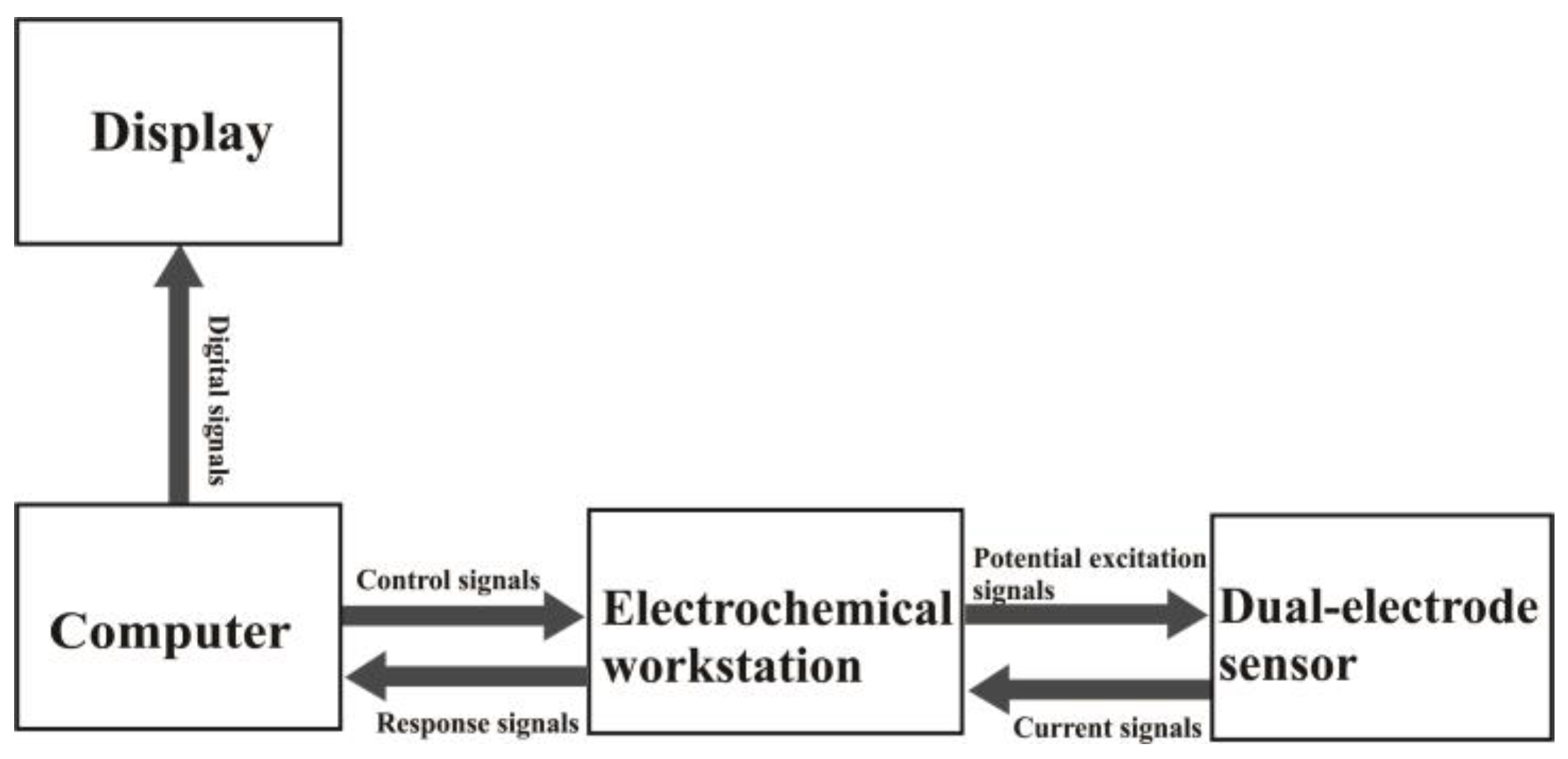

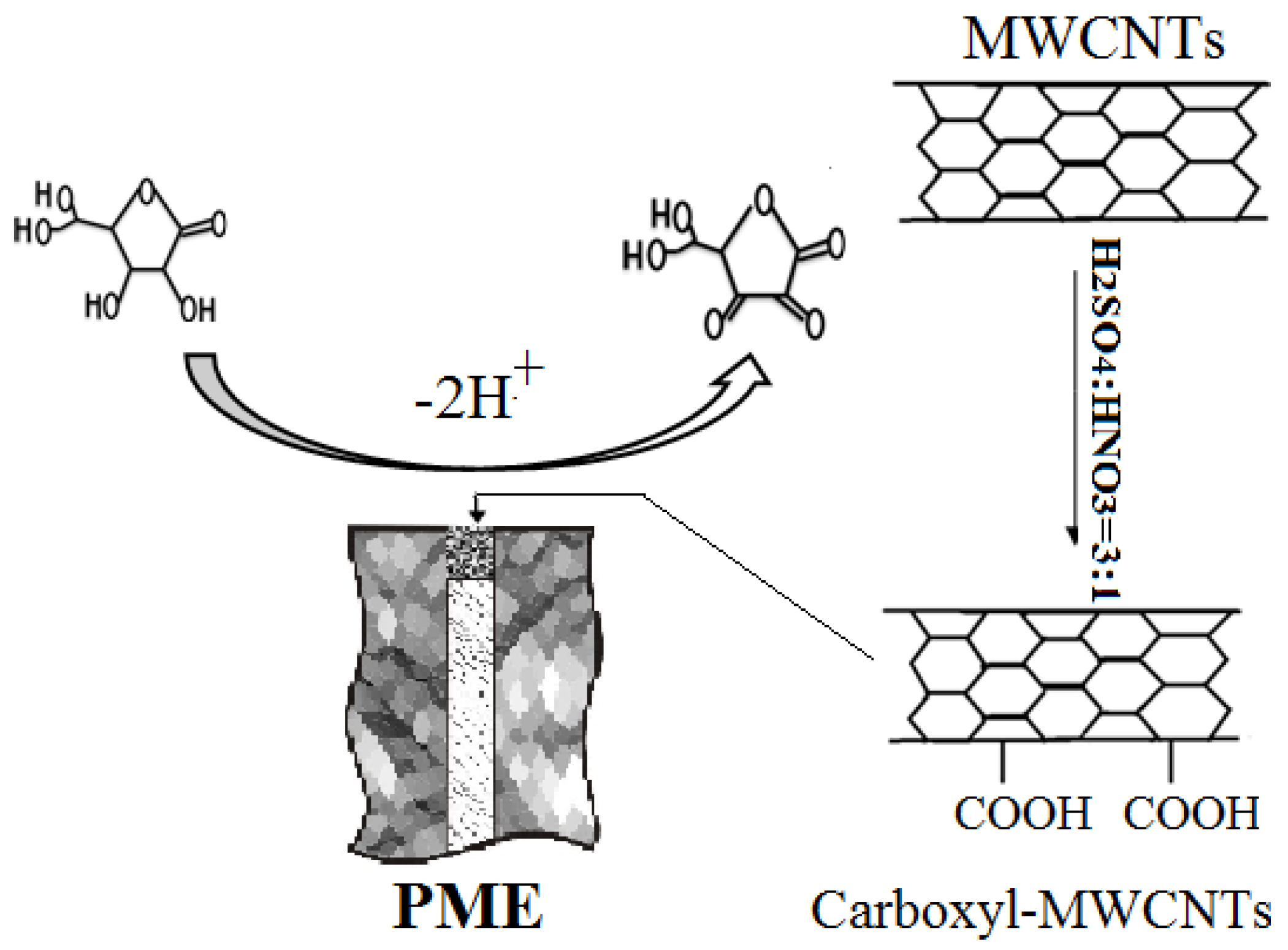
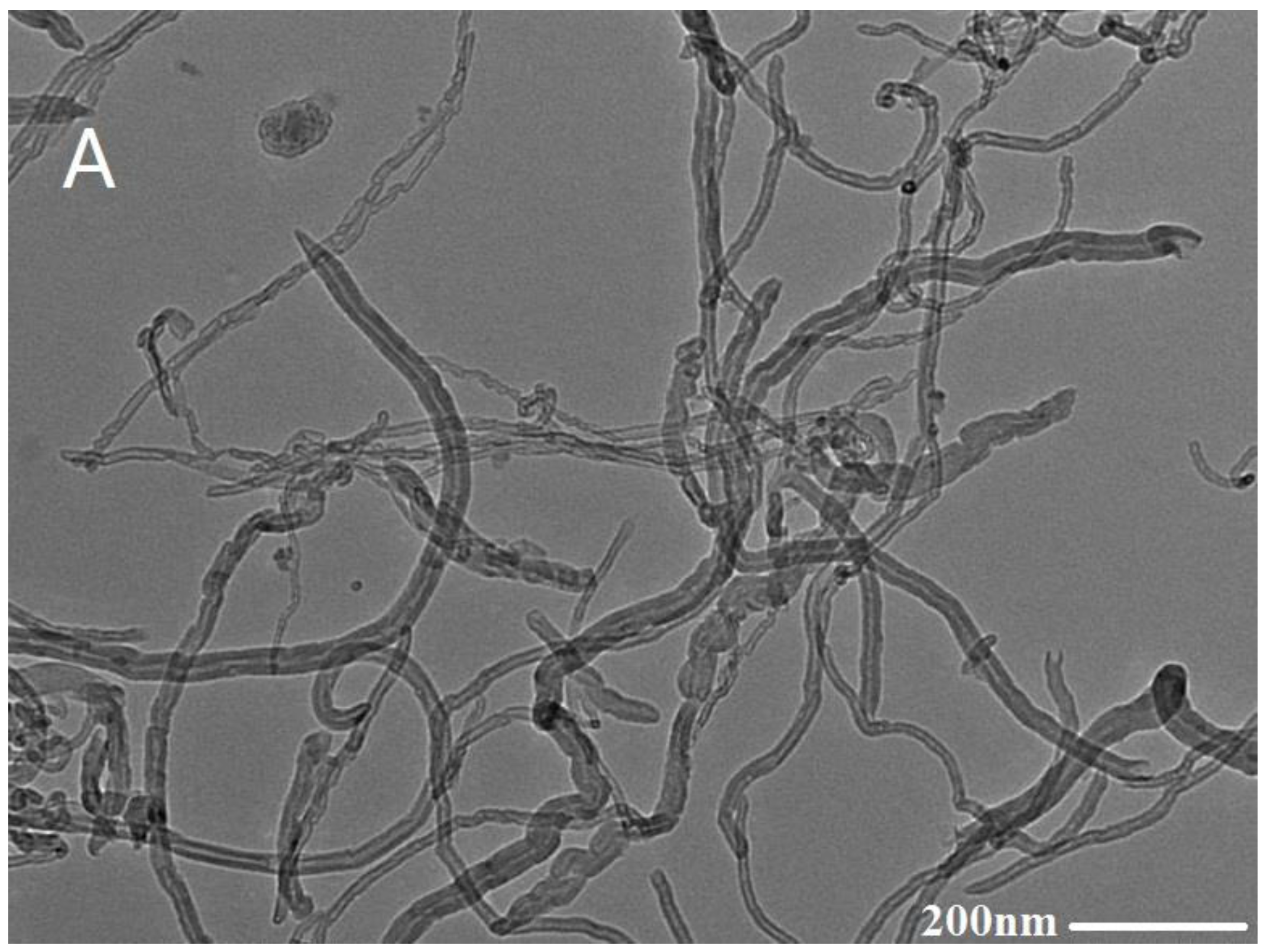
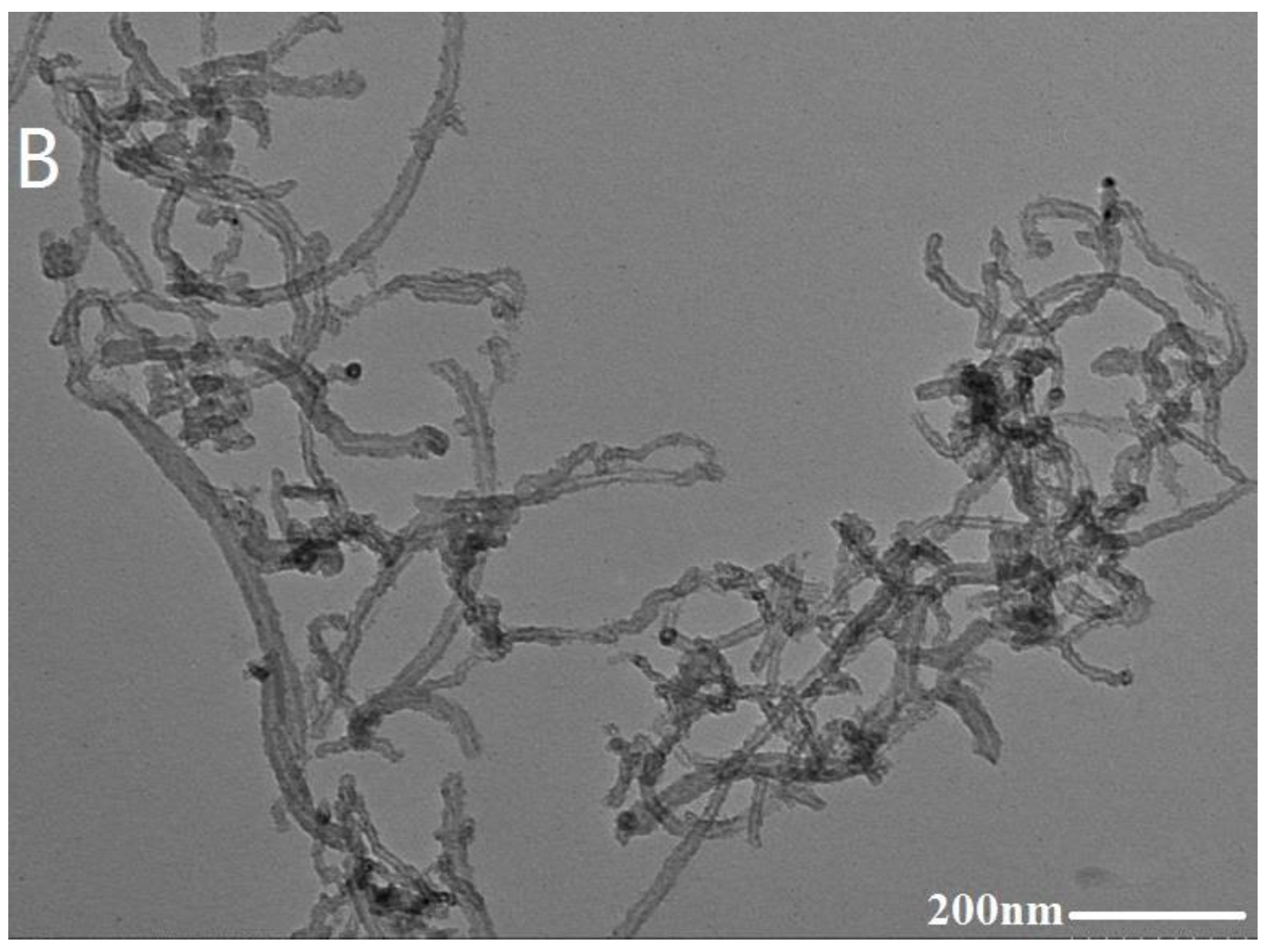


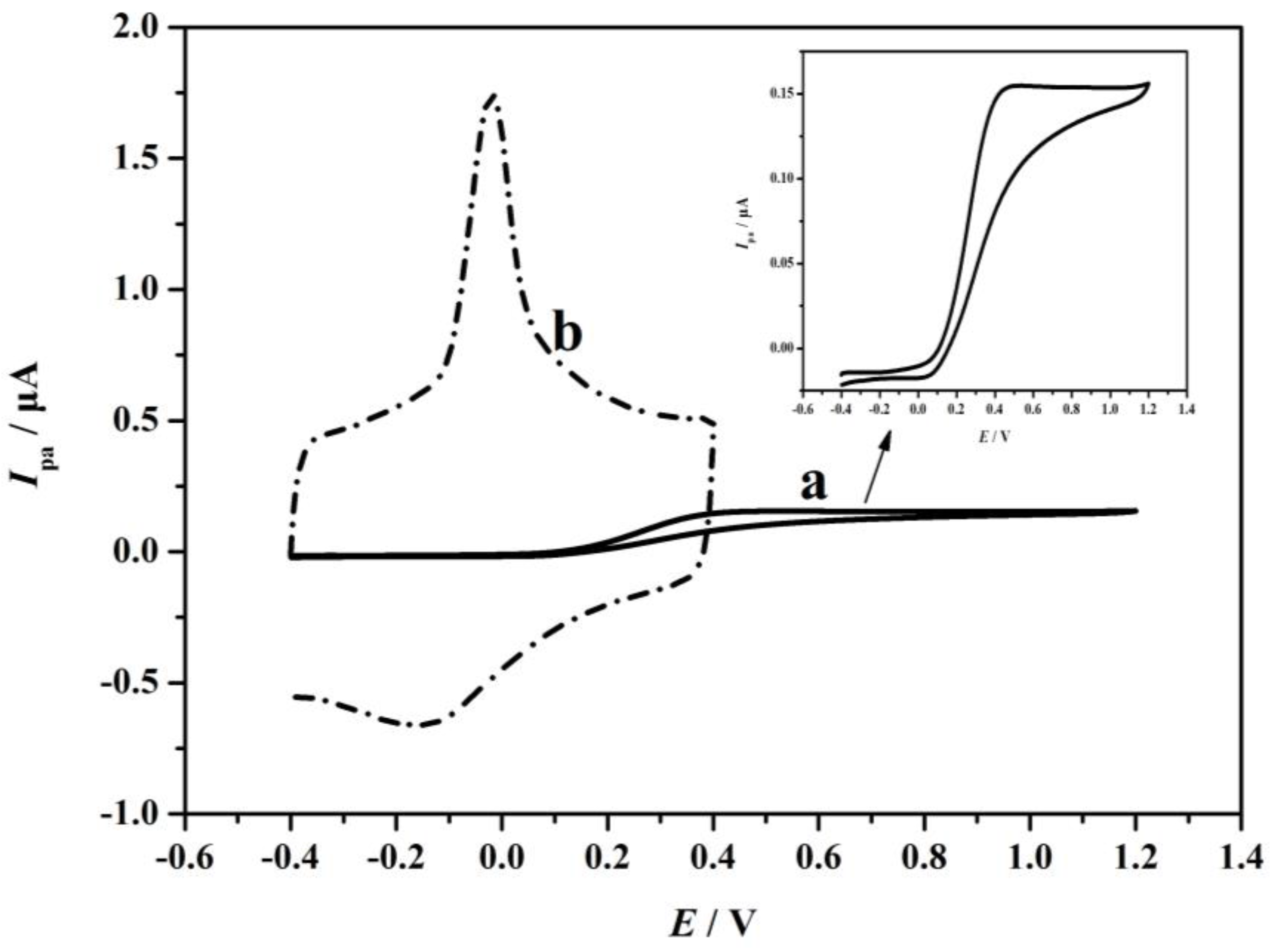

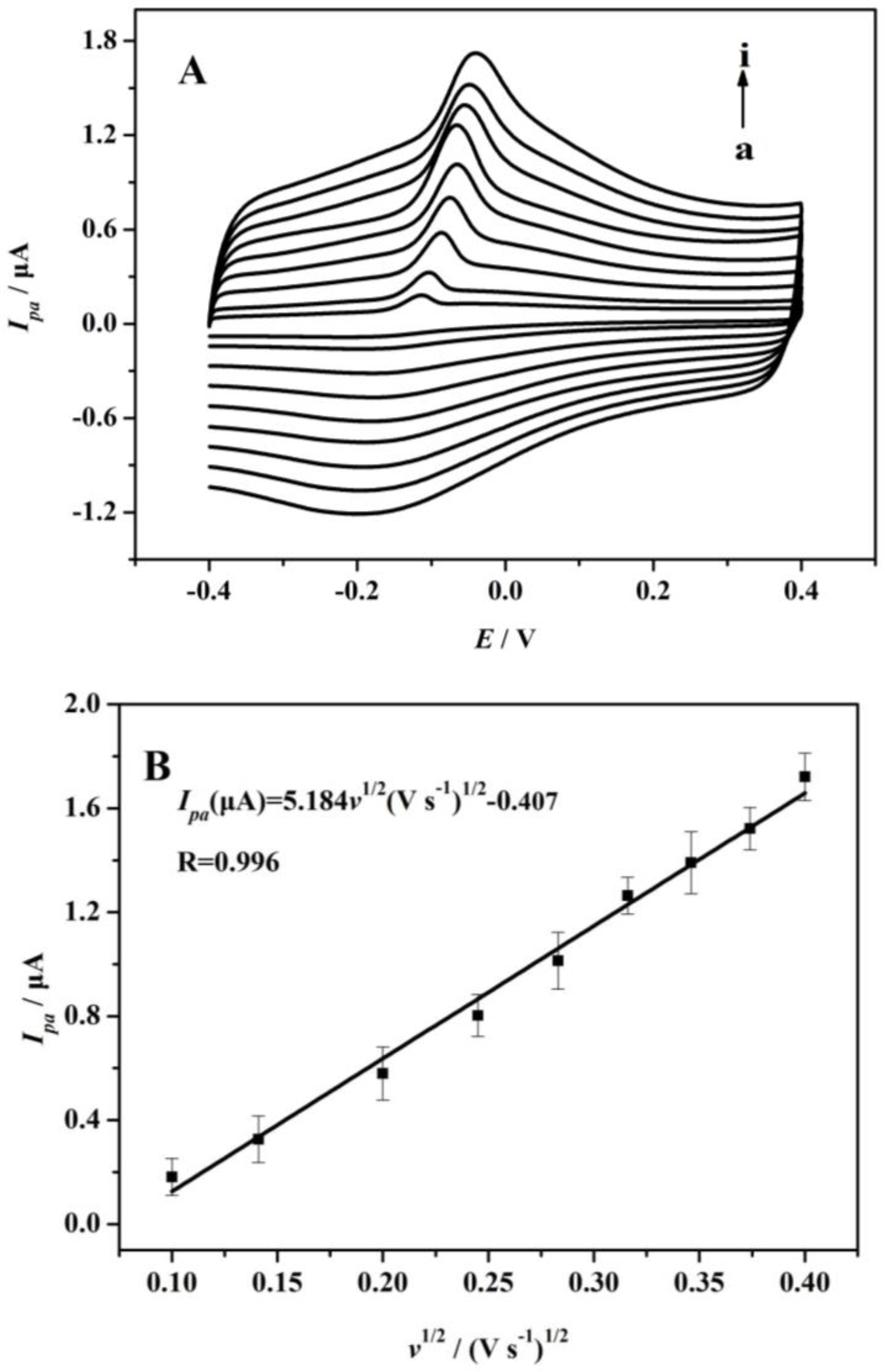
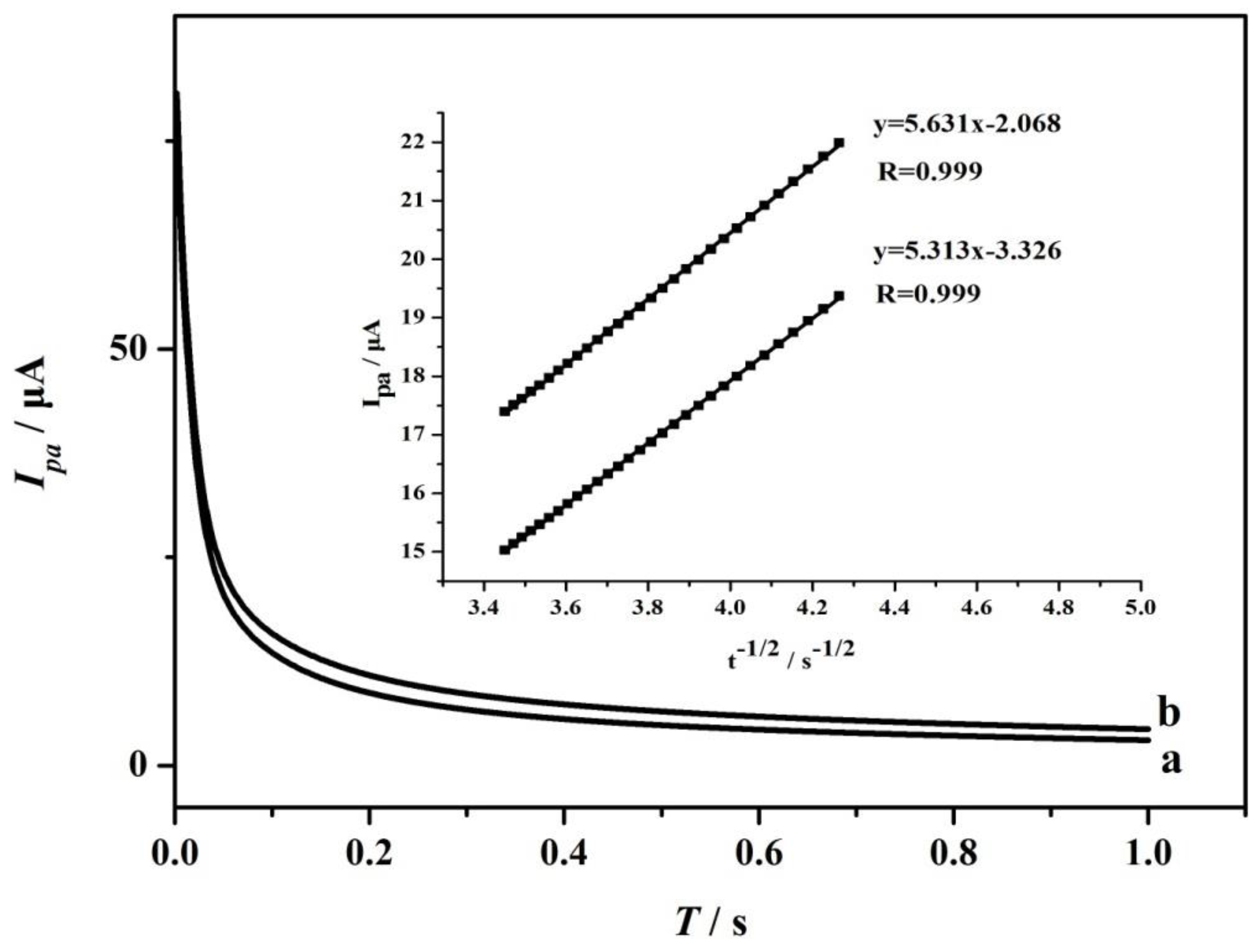

| Electrode | Method | Potential | Linearity Range | LOD | Real Sample | Reference |
|---|---|---|---|---|---|---|
| Tm2O3/ITO | CV | 0.60 V | 0.2~8 mmol·L−1 | 0.42 mmol·L−1 | No mentioned | [19] |
| Pan/SWi12/TiO2-MoO3 | DPV | 0.27 V | 0.95~6.9 mmol·L−1 | 1.2 μmol·L−1 | Tomato, orange juice | [41] |
| PAn-β-naphthalenesulfonic acid | CV | 0.35 V | 5~60 mmol·L−1 | 12.93 μmol·L−1 | Not mentioned | [42] |
| Molecularly imprinted PAN | DPV | 0.05~0.4 mmol·L−1 | 18 μmol·L−1 | Vitamin C tablet | [43] | |
| An-β-aminobenzenesulfonic acid | DPV | 0.15 V | 35~175 μmol·L−1 | 7.5 μmol·L−1 | Vitamin C tablet | [44] |
| Fc+-thioglycolate | DPV | 0.164 V | 1.0~500 μmol·L−1 | 0.2 μmol·L−1 | Human urine | [45] |
| Poly-Trypan Blue | DPV | 0.15 V | 1.0~630 μmol·L−1 | 0.1 μmol·L−1 | Vitamin C/serum | [46] |
| L-Cysteine sonogel-carbon | SWV | −0.1 V | 0.05~1 mmol·L−1 | 0.05 mmol·L−1 | Serum | [47] |
| CeO2 NP/GC | DPV | 0.1 V | 1.0~500 μmol·L−1 | 5 μmol·L−1 | Serum | [48] |
| PdNi/C/GCE | Amperometric response | 0.01~1.8 mmol·L−1 | 0.5 μmol·L−1 | Vitamin C | [49] | |
| PME | Amperometric, CV | −0.02 V | 5.0~950 μmol·L−1 | 0.489 μmol·L−1 | Lemon | This work |
| Matrix | AA’s Peak Current Value before Matrix Addition (μA) | AA’s Peak Current Value after Matrix Addition (μA) | Matrix Effect |
|---|---|---|---|
| 2 mol·L−1 KCl | 8.563 | 8.493 | 99.18% |
| 2 mol·L−1 NaCl | 8.357 | 8.270 | 98.95% |
| 2 mol·L−1 MgSO4 | 8.235 | 7.985 | 96.97% |
| 2 mol·L−1 NH4Cl | 8.727 | 8.431 | 96.61% |
| 2 mol·L−1 CaCl2 | 8.128 | 7.786 | 95.79% |
| 1 mol·L−1 glucose | 8.176 | 8.085 | 98.89% |
| 2 mol·L−1 sucrose | 8.319 | 7.962 | 95.71% |
| 2 mol·L−1 fructose | 8.256 | 8.167 | 98.92% |
| 1 mol·L−1 vitamin E | 8.437 | 8.230 | 97.54% |
| 1 mol·L−1 polyphenol | 8.356 | 8.043 | 96.25% |
| Sample | Additive (10−5 mol·L−1) | Found (10−5 mol·L−1) | Recovery (%) | RSD (%) |
|---|---|---|---|---|
| Lemon | 1.00 | 0.97 | 97% | 4.7 |
| 2.00 | 1.91 | 96% | 3.9 | |
| 3.00 | 3.14 | 105 | 4.5 | |
| Apple | 1.00 | 0.95 | 95% | 3.3 |
| 2.00 | 1.95 | 98% | 2.9 | |
| 3.00 | 2.83 | 94% | 2.5 | |
| Vitamin C tablets | 1.00 | 0.96 | 96% | 4.1 |
| 2.00 | 2.14 | 107% | 4.6 | |
| 3.00 | 2.92 | 97% | 3.7 |
© 2017 by the authors. Licensee MDPI, Basel, Switzerland. This article is an open access article distributed under the terms and conditions of the Creative Commons Attribution (CC BY) license (http://creativecommons.org/licenses/by/4.0/).
Share and Cite
He, B.-S.; Zhang, J.-X. Rapid Detection of Ascorbic Acid Based on a Dual-Electrode Sensor System Using a Powder Microelectrode Embedded with Carboxyl Multi-Walled Carbon Nanotubes. Sensors 2017, 17, 1549. https://doi.org/10.3390/s17071549
He B-S, Zhang J-X. Rapid Detection of Ascorbic Acid Based on a Dual-Electrode Sensor System Using a Powder Microelectrode Embedded with Carboxyl Multi-Walled Carbon Nanotubes. Sensors. 2017; 17(7):1549. https://doi.org/10.3390/s17071549
Chicago/Turabian StyleHe, Bao-Shan, and Jun-Xia Zhang. 2017. "Rapid Detection of Ascorbic Acid Based on a Dual-Electrode Sensor System Using a Powder Microelectrode Embedded with Carboxyl Multi-Walled Carbon Nanotubes" Sensors 17, no. 7: 1549. https://doi.org/10.3390/s17071549





